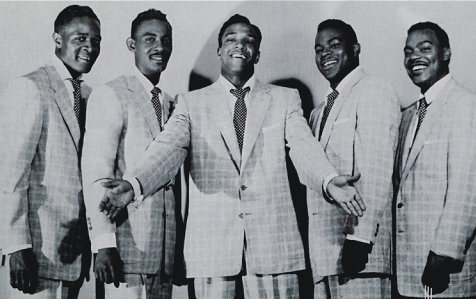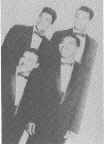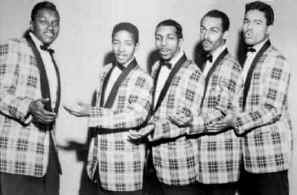Doo-Wop
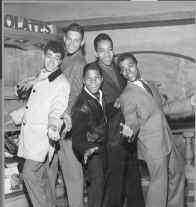
Frankie Lymon and the Teenagers.
Style of rhythm-and-blues and rock-and-roll vocal music popular in the 1950s and '60s.
The structure of doo-wop music generally featured a tenor lead vocalist singing the melody of the song with a trio or quartet singing background harmony. The term doo-wop is derived from the sounds made by the group as they provided harmonic background for the lead singer.
The roots of the doo-wop style can be found as early as the records of the Mills Brothers and the Ink Spots in the 1930s and '40s. The Mills Brothers turned small-group harmony into an art form when, in many of their recordings, they used their vocal harmony to simulate the sound of string or reed sections. The Ink Spots established the preeminence of the tenor and bass singer as members of the pop vocal ensemble, and their influence can be heard in rhythm-and-blues music beginning in the 1940s (in records by the Ravens), throughout the '50s, and well into the '70s. This influence is best exhibited in the remakes of the Ink Spots' hit records “My Prayer” (1956) by the Platters and “If I Didn't Care” (1970) by the Moments. In fact, Motown's premier male group of the 1960s and '70s, the Temptations, had a vocal sound that was based in this classic doo-wop style, with the Ink Spots' tenor lead singer, Bill Kenny, and bass singer, Hoppy Jones, serving as inspiration for the Temptations' lead singers, Eddie Kendricks and David Ruffin, and their bass singer, Melvin Franklin. There also was a school of female doo-wop, best exemplified by the Chantels, the Shirelles, and Patti LaBelle and the Bluebelles.
The popularity of doo-wop music among young singers in urban American communities of the 1950s such as New York City, Chicago, and Baltimore, Maryland, was due in large part to the fact that the music could be performed effectively a cappella. Many young enthusiasts in these communities had little access to musical instruments, so the vocal ensemble was the most popular musical performing unit. Doo-wop groups tended to rehearse in locations that provided echoes—where their harmonies could best be heard. They often rehearsed in hallways and high school bathrooms and under bridges; when they were ready for public performance, they sang on stoops and street corners, in community centre talent shows, and in the hallways of the Brill Building. As a result many doo-wop records had such remarkably rich vocal harmonies that they virtually overwhelmed their minimalist instrumental accompaniment. Doo-wop's appeal for much of the public lay in its artistically powerful simplicity, but this “uncomplicated” type of record also was an ideal, low-budget investment for a small record company to produce. The absence of strings and horns (“sweetening”) in their production gave many of the doo-wop records of the early 1950s an almost haunting sparseness. The Orioles' “What Are You Doing New Years Eve?” (1949) and “Crying in the Chapel” (1953), the Harptones' “A Sunday Kind of Love” (1953), and the Penguins' “Earth Angel” (1954) are excellent examples of this effect.
An unfortunate by-product of the poetic simplicity of doo-wop records was that it was relatively easy for major labels to cover (re-record) those records with greater production values (including the addition of strings and horns) and with a different vocal group. Consistent with the racial segregation of much of American society in the 1950s, the practice of major record labels producing cover records usually involved doo-wop records that were originally performed by African-American artists being re-created by white artists, the objective being to sell these covers to a broader, “pop” (white) audience. Among the legion of doo-wop records that suffered this fate were the Chords' “Sh-Boom” (covered by the Crew-Cuts in 1954) and the Moonglows' “Sincerely” (covered by the McGuire Sisters in 1955). A number of white singing groups adopted the doo-wop style—particularly Italian-American ensembles who shared the same urban environment with the African Americans who originated doo-wop. Like the phenomenon of cover records, the advent of the “clean-cut” teen idols who prospered on American Bandstand, and the popularity of blue-eyed soul, this version of doo-wop further exemplified how black music was co-opted by the white recording industry. Prominent practitioners of the “white doo-wop” sound were the Elegants (“Little Star” [1958]), Dion and the Belmonts (“I Wonder Why” [1958]), and the Four Seasons' (“Sherry” [1962]). Ultimately, the musical power of doo-wop has flowed from the original groups through the Motown music of the 1960s and the Philly Sound of the '70s and continued into the urban contemporary music of the '90s.
Frederick Dennis Greene
Representative Works ·The Ink Spots, “If I Didn't Care” (1939) ·The Ravens, “Write Me a Letter” (1947) ·Sonny Til and the Orioles, “Crying in the Chapel” (1953) ·The Chords, “Sh-Boom” (1954) ·The Mills Brothers, Meet the Mills Brothers (1954) ·The Moonglows, “Sincerely” (1954) ·Frankie Lymon and the Teenagers, “Why Do Fools Fall in Love?” (1956) ·The Platters, The Fabulous Platters (1956) ·The Chantels, “Maybe” (1958) ·Dion and the Belmonts, “I Wonder Why” (1958) ·Little Anthony and the Imperials, “Tears on My Pillow” (1958) ·The Four Seasons, “Sherry” (1962) ·Patti LaBelle and the Bluebelles, The Apollo Presents the Bluebelles (1963) ·The Temptations, Temptations Sing Smokey (1965)
Additional Reading
Arnold Shaw, The Rockin' '50s: The Decade That Transformed the Pop Music Scene (1974, reprinted 1987), is a behind-the-scenes autobiographical narrative of the music business of the 1950s with candid reminiscences of the racial aspects of the industry, while Honkers and Shouters: The Golden Years of Rhythm and Blues (1978, reissued 1986), provides a history of the early days of rock and roll. Philip Groia, They All Sang on the Corner: A Second Look at New York City's Rhythm and Blues Vocal Groups (1983), presents a well-researched social history of the doo-wop scene in New York City. Robert Pruter, Doowop: The Chicago Scene (1996), offers authoritative analysis of the seminal doo-wop music world of Chicago, a city more traditionally identified with blues. Charlie Gillett, The Sound of the City: The Rise of Rock and Roll, 2nd ed., newly illustrated and expanded (1996), is a comprehensive examination of the rise of rock and roll as a multicultural phenomenon. Patti LaBelle, Don't Block the Blessings: Revelations of a Lifetime (1996), is an autobiographical narrative of the life and career of one of the greatest voices in rock music.
The Chords
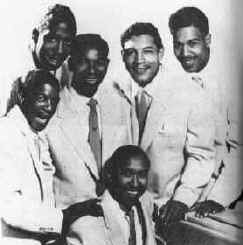
The Chords-- Carl and Claude Feaster (lead and baritone), Jimmy Keyes (first tenor), Floyd "Buddy" McRae (second tenor), and Ricky Edwards (bass) --- formed in 1951 in the Bronx, but weren't discovered until three years later, when they were spotted singing in a subway station, a performance that ultimately landed them a recording contract with Atlantic Records.
Jerry Wexler, Atlantic's top talent A&R man, had the Chords cover a Patti Page hit, "Cross Over the Bridge" (it was also covered by the Flamingos for Chance), but it was the B-side, "Sh-Boom," a swinging R&B vocal tune with a catchy intro made up of seemingly nonsensical syllables ("shh-boom, shh-boom, yadda da da yadda da da da da da") that caused considerably more commotion.
"Sh-Boom" is supposed to have been titled after the threat of an atom bomb explosion -- Shhhh-BOOM! -- which, in the midst of Cold War posturing in 1954, was a very real topic on the public's collective consciousness. However, this demented ditty also included the surreally optimistic message that everything was ultimately fine and as the rest of the lyrics suggested, "life could be a dream." By the end of June 1954, "Sh-boom" had climbed up the charts nationwide, charting on both the R&B (number five) and pop (number two) lists, a nearly unprecedented feat for its time.
For all practical purposes -- along with the Crows' 1953 hit "Gee" (another upbeat B-side hit that DJs flipped over) -- "Sh-Boom" introduced the white audience to black R&B music for the first time. Not everyone thought the song was a precursor of good things to come. Peter Potter, host of TV's popular "Juke Box Jury," was seemingly aghast at the state of this then-new trend in pop music and attacked "Sh-Boom" asking if anyone would remember the admittedly demented ditty in five, let alone 20 years time and whether any record label would even think to re-release it in the future.
The answers to his rhetorical questions were, of course, yes and yes. The songwriters were deluged by music publishing companies wanting to buy the rights to "Sh-Boom" in order to reap huge potential earnings (the group quickly came to an agreement with Hill & Range). Soon there were cover versions hitting radio stations across the country simultaneously with the Chords' original single.
Some were memorable and some otherwise,including a countrified take by the Billy Williams Quartet for Coral, and -- more notably -- the Crew Cuts' version for Mercury. The Chords soon appeared on TV shows (still an invention not yet in many U.S. homes), but were knocked for a loop when they learned there was a more-obscure group already using the name Chords. They were forced to change their name to the Chordcats.
Subsequent Atlantic record ads noted that their group was the creators and originators of "Sh-Boom," even though the Canadian Crew Cuts' paler pop version by then had knocked the Chords' R&B-styled version off the charts. Atlantic later moved the Chords over to their new Cat Records subsidiary, releasing numerous additional singles which mostly failed to chart. A last gasp attempt to resurrect the act came in mid-1955 when the group renamed themselves the Sh-Booms after their one big hit.
The Chords/Chordcats/Sh-Booms went through several personnel changes during the late '50s, recording a handful of forgettable records for Vik Records in 1957, and eventually returned to Atlantic in 1960 for one last recording before slipping away into the ether of time. -- Bryan Thomas
The Cleftones

Formed in Queens, NY, in 1955, the Cleftones consisted of five friends from Jamaica High School -- Herb Cox (lead), Warren Corbin (bass), Charlie James (first tenor), William McClain (baritone), and Berman Patterson (second tenor). Originally signed to Gee, the group released its first single, "You Baby You," late in 1955; an up-tempo doo wop song, the record became a regional hit.
"Little Girl of Mine," the Cleftones' second single, broke nationally, charting at number eight R&B and number 57 pop in 1956; two other similar singles, "Can't We Be Sweethearts" and "String Around My Heart," were released the same year, yet they failed to attract national attention. "See You Next Year," a ballad the group recorded in 1957, did not earn the group an audience outside of New York. Two years later, McClain eft the group and was replaced by Gene Pearson from the Rivileers. Patricia Spann was also added to the Cleftones' lineup that year, which helped nudge the band away from traditional group-oriented doo wop harmonies and towards a vocal sound that was dominated by the lead vocals. In 1961, the Cleftones realized the potential of the sound with their smash hit version of the standard "Heart and Soul;" it became the group's biggest hit, reaching number 18 on both pop and R&B charts.
Later that year, the group had another hit with "For Sentimental Reasons," but the band had reached a peak with "Heart and Soul" and were never able to reach those heights again. The Cleftones broke up in 1964, three years after their greatest success. ~ Stephen Thomas Erlewine, All-Music Guide
The Crest
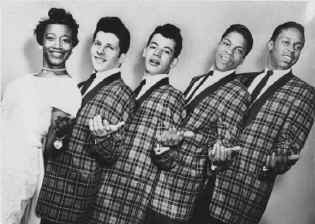
One of the most successful integrated doo-wop groups, The Crests waxed the classic ballad "16 Candles" in 1959. Formed in 1956, they began recording the next year for Joyce, where they inched onto the pop lists with "Sweetest One." Moving to the brand-new Coed logo, Johnny Maestro's (b. May 7, 1940) warm tenor made "16 Candles" a national smash, and pop/R&B hybrids like "The Angels Listened In" and "Step by Step" also did well.
Maestro went solo in 1960, scoring the next year with "Model Girl" on Coed, while The Crests attempted to survive on their own. Maestro eventually reclaimed stardom as leader of Brooklyn Bridge, an 11-piece aggregation that hit with "Worst That Could Happen" in 1968. ~ Bill Dahl, All-Music Guide
The Crows
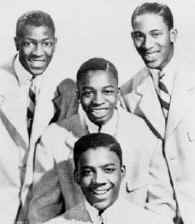
One of the first doo wop groups, one of the first so-called "bird" groups, and one of the first acts of any kind to score a bonafide rock & roll hit record, The Crows were among the more important one-shot artists in rock & roll history. Discovered at New York's Apollo Theater in 1952, The Crows were one of the many groups pioneering doo wop with their infectious, cheerful vocals and harmonies, use of nonsense syllables, and modified jump blues instrumental backing.
Cut in 1953, "Gee," with its irresistible melody, naively enthusiastic street-corner singing, and Charlie Christian-like guitar solo, was far and away their best single. It was also their only successful one, although it needed almost a year to take off, reaching number 14 in the pop charts (and number two in the R&B charts) in early 1954. Recording about a half-dozen other 45s between 1952 and 1954, the group broke up with little fanfare only months after "Gee" fell off the hit parade. ~ Richie Unterberger
Danny and the Juniors
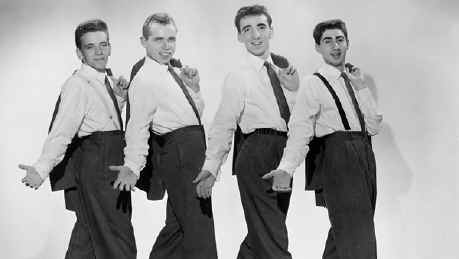
Danny Rapp, Joe Terranova, Dave White, and Frank Maffei Danny and the Juniors are best remembered for their 1958 #1 hit "At the Hop." Danny and the Juniors were four Philadelphia teenagers that formed a group called the Juvenairs. The group consisted of Dave White Tricker, tenor; Joseph Terranova, baritone/bass; Frank Maffei, second tenor; and Danny Rapp, lead tenor. Rapp acted as the group's choreographer, teaching the others steps and routines to use on stage to make their act more exciting. One night in late 1957, they were working a record hop as the intermission entertainment. They were spotted by Johnny Madera, a local man who dabbled in the music business.
Madera was impressed enough to mention them to Artie Singer, a local songwriter and vocal tutor. Singer, with his own label Singular Records, invited them to audition. They ran through a few standard vocals they had been rehearsing before Singer asked them if they had any original material.. David White had composed a piece he called "Do the Bop." Singer liked it and had the group cut a demo for him to test on local deejays. One of the first people to receive a copy was Dick Clark, who like Singer, was impressed.
Clark made to suggestions. Shorten the name of the group from the Juvenairs to the Juniors and since the term "bop" was out of fashion the song's title needed to be changed. The sound was renamed "At The Hop" and the group went to Reco-Art Studios in Philadelphia to b re-record the song. After taking thirteen takes to get it right, the song was sent to Clark. Clark loved it , but didn't have any immediate openings. However, Little Anthony and the Imperials cancelled an appearance on American Bandstand and Clark called Danny and the Juniors to be their replacements. The record took off and selling 7,000 copies in week in Philadelphia alone. Financially strapped Singular Records couldn't handle the massive orders and leased the record to ABC Paramount for $5,000. The group toured frequently the next few years with Alan Freed's revue. They had a few minor hits.
The most notable being the followup "Rock and Roll Is Here To Stay." In the early sixties the group switched to the Swan label and had their last charted song in 1963. The group's saxaphonist, Lenny Baker, co-founded Sha Na Na in the late sixties. Danny Rapp, the lead singer, committed suicide in 1983.
The Dells
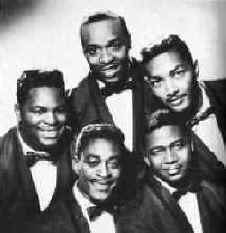
The Dells, 1956.
Left to right: Marvin Junior, Verne Allison, Chuck Barksdale, Mickey McGill and Johnny Funches. After nearly four decades of recording an incredible legacy of hits, The Dells have made only one personnel change in their entire professional career. Perhaps that's why the venerable R&B vocal group can boast such a remarkably consistent track record.
The quintet from Chicago's south suburbs has weathered stylistic shifts from doo-wop and soul to disco and urban contemporary, and every permutation in between. Their harmony remains as striking as ever, with Marvin Junior's earthshaking lead enduring as the group's focal point. Signing with Vee-Jay in 1955, their creamy vocal blend on "Oh,What a Night" gave The Dells their first major R&B hit the next year, but it would be nearly a decade before they returned to the winner's circle with another dreamy classic, "Stay in My Corner."
By then Chicago's R&B sound had changed drastically -- doo-wop was dead and soul was king -- but The Dells adapted effortlessly, regularly scaling the charts for the Chess subsidiary Cadet with "There Is," "Always Together," "Give Your Baby a Standing Ovation," and a marathon remake of "Stay in My Corner" that afforded Junior's booming baritone room to roam. Seemingly an indestructible force (turning up on the R&B charts as recently as 1984), the succinct harmonies of The Dells span entire generations of R&B history. ~ Bill Dahl, All-Music Guide
The Drifters
The name "Drifters" was chosen by Clyde McPhatter, who was the first in a long line of lead voices. He could not have chosen a better name, since members drifted in and out of the band from the very beginning. The group's members included: McPhatter, Ben E. King, Rudy Lewis, Johnny Moore, Bill Pinkney, Gerhart Thrasher and Charlie Thomas.
They had Number One singles with three different singers - McPhatter, Moore and King - which must stand as some kind of record. The era of Clyde McPhatter and the Drifters, which lasted only from 1953-4, and produced "Money Honey" (a number one R&B hit), "Honey Love" and "White Christmas."
With Ben E. King as lead vocalist, the Drifters began working with Leiber and Stoller in 1959. The first fruit of their union was "There Goes My Baby," a pop-R&B classic. Other hits of the King era include "Save the Last Dance for Me," the Drifters' only single to top both the pop and R&B charts, and "This Magic Moment." King, too, departed for a solo career, recording "Spanish Harlem" and "Stand By Me," both of them soulful classics that have stood the test of time.
The Dubs
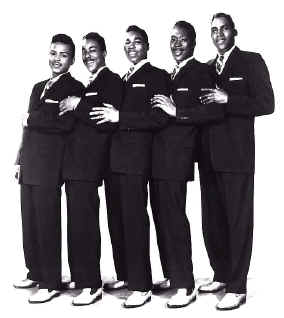
The Dubs made one of the mid-'50s' more endearing ballad records, "Could This Be Magic," in 1957. It wasn't a huge hit, but still became a doo wop classic. The group, featuring lead vocalist Richard Blandon, continued recording for Gone, Musictone, ABC, End, Josie, Wilshire, Lana, Candlelite, Johnson, and Clifton through the mid-'70s, but never enjoyed any success or made any headway outside doo wop circles. ~ Ron Wynn, All-Music Guide
The Duprees
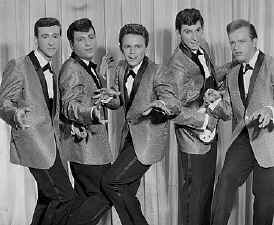
One of the final Italian doo wop groups to make a wave in the early '60s, the Duprees were in some senses not a rock & roll act at all. They relied on updates of pre-rock pop standards for most of their material, dressed up in classy big-band arrangements. Their New Jersey street-corner roots were still audible in their doo wop harmonies, giving their treatments of moldy oldies enough of a contemporary flavor to compete in the rock and pop marketplace. They were very good at what they did, and in 1962-63, they were very successful: "You Belong to Me" (previously recorded by Jo Stafford, Patti Page, Dean Martin, and Joni James) made the Top Ten, and "My Own True Love" (from the soundtrack of Gone with the Wind), "Have You Heard," and "Why Don't You Believe Me" were also Top 40 hits. The Duprees were already retro when they were at their peak, and were washed out by the British Invasion, although they continued to record throughout the late '60s, sometimes in a Jay & the Americans/Vogues style. ~ Richie Unterberger, All-Music Guide
The Elegants
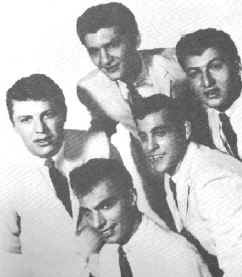
This New York doo wop group earned notoriety for their masterpiece "Little Star" in 1958, which topped both R&B and pop charts. They were a White ensemble led by Vito Picone, With Arthur Venosa, Frank Tardogno, Carmen Romano, And James Mochella. All had been in other groups before uniting as The Elgins. They continued recording for Hull, United Artists, Limelight, Photo, IPG, and Laurie through the '50s, '60s and into the '70s, but never had another hit, despite cutting a number of solid ballads. There were two other editions in the mid-'60s, Vito Piccone with the Elegants and Vito & The Elegants. ~ Ron Wynn, All-Music Guide
The Five Satins

The Five Satins are best-known for the doo-wop classic "In the Still of theNight," a song that was popular enough to make the group one of the most famous doo-wop outfits, although they never had another hit of the same magnitude.
The origins of the Five Satins lie in the Scarlets, a New Haven, Connecticut doo-wop group led by Fred Parris. The Scarlets formed in 1953, while Parris was still in high school. The group had a local hit with "Dear One" the following year. In 1954, Parris formed the Five Satins with vocalists Al Denby, Ed Martin and Jim Freeman. Within the next year, Parris had the group record "In the Still of the Night," a song he had recently written, in the basement of a local church. The first single the group released was "In the Still of the Night." The single was released on Standard Records in the spring of 1956. By the end of the year, it had been leased to Ember and it became a huge hit, peaking at number three on the R&B charts and number 25 on the pop charts.
By the time "In the Still of the Night" scaled the charts, Parris had been drafted into the army. He was stationed in Japan when the song became a hit and he was still stationed in Japan when the group recorded the followup single, "To the Aisle." For that single, Bill Baker handled the lead vocals. "To the Aisle" became a Top Ten R&B hit (number 25 pop) in the summer of 1957. Parris returned from the army in 1958. Upon his return, he re-organized the group, adding Richie Freeman, Sylvester Hopkins, West Forbes, and Lou Peeples. This incarnation of the group had a minor hit in the fall of 1959 with "Shadows."
In 1960, "In Still of the Night" re-entered the pop charts thanks to its exposure on Art Laboe's first Oldies But Goodies compilation. The repeated success of the single sparked a another minor hit for the band in 1960 -- the group's cover of the standard "I'll Be Seeing You" scraped the bottom of the pop charts in the summer of that year. Early in 1961, "In the Still of the Night" entered the pop charts again. During the remainder of the '60s, Parris led various incarnations of the Five Satins through oldies revues in America and Europe; they also recorded occasionally during this time. In 1970, the group appeared in the film, Been Down So Long It Looks Like Up to Me; three years later, they appeared in Let the Good Times Roll.
In the early '70s, the Five Satins continued to play the oldies circuit under the direction of Fred Parris. In 1974, the group signed a contract with Kirsner Records and reelased a single, "Two Different Worlds." Two years later, they briefly changed their name to Black Satin and released a single called "Everybody Stand Up and Clap Your Hands (For the Entertainer)," which became a Top 50 R&B hit. Shortly afterward, the group reverted to the Five Satins name.
In 1982, the Five Satins had their last hit with a doo-wop medley entitled "Memories of Days Gone By." The single, which was released on Elektra Records, peaked at number 71 on the pop charts. For the remainder of the '80s and the '90s, Fred Parris led various lineups of the Five Satins and the group performed regularly at oldies shows in America and Europe. ~ Stephen Thomas Erlewine, All-Music Guide
The Flamingos

The Flamingos, 1954. Clockwise from top left: Paul Wilson, Sollie McElroy, Zeke Carey, Johnny Carter and Jake Carey Both prolific and seminal in their influence and impact, The Flamingos may have been the greatest harmonizing vocal ensemble ever, and were certainly among the premier units of the doo wop/R&B era. Cousins Jake and Zeke Carey moved to Chicago from Baltimore in 1950. They met Paul Wilson and Johnny Carter at the Church of God and Saints of Christ Congregation, a black Jewish church.
They began singing in the choir, and the foursome met Earl Lewis (not The Channels' lead vocalist) through one of the members' sisters, who was his girlfriend at the time. They originally called themselves The Swallows, but had to change names when they found out that a Baltimore group already had the name.
Carter suggested El Flamingos, which was changed to The Five Flamingos, and later The Flamingos. Ralph Leon of the King Booking Agency eventually became their manager. Sollie McElroy replaced Lewis as their lead singer in the early '50s, with Lewis joining The Five Echoes. They recorded with Chance in 1953, and "If I Can't Have You" attracted some attention and did well in the Midwest and on the East Coast.
"That's My Desire" and "Golden Teardrops" were marvelously sung numbers, particularly "Golden Teardrops," with its sweeping harmonies on top and bottom framing McElroy's wondrous lead. But none of their great Chance recordings generated enough national attention to make the R&B charts, nor did the three numbers they recorded for Parrot. McElroy departed and was replaced by Nate Nelson.
They enjoyed their first chart success with Checker in the late '50s, scoring a Top Ten R&B hit with "I'll Be Home" in 1956. They temporarily disbanded in 1956 and regrouped in 1957 with Nelson, Jake Carey, Paul Wilson, and Tommy Hunt as the lineup, and the group now a quartet. Zeke Carey returned in 1958, and they signed with End late that year.
"I Only Have Eyes for You" in 1959 was their biggest hit, peaking at number three R&B and number 11 pop. It was a cover of a song that had been a huge hit for Eddy Duchin in 1934, and was the start of a productive period that saw The Flamingos issue four albums for End and get two more R&B Top 30 singles, one the Sam Cooke composition "Nobody Loves Me like You" in 1960. Hunt left in 1961, and the group returned briefly to Checker in 1964.
They later recorded for Phillips, Julman, and Polydor, but couldn't regain their former standing. They remained among the genre's most beloved groups, and anthologies of their material on Chance and Checker have been reissued. In 1993, The Flamingos Meet the Moonglows was reissued by Vee-Jay. ~ Ron Wynn, All-Music Guide
The Harptones
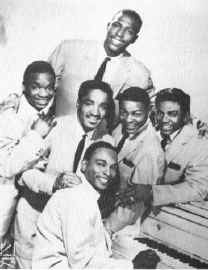
William Dempsey, Jimmy Beckum, , William Brown and Willie Winfield Despite not landing on the R&B or pop charts for their entire careers, the Harptones were a superb doo wop ensemble. They initially emerged from a 1953 union of members of the Harps and Skylarks. Willie Winfield and his brothers Jimmy and Clyde first teamed with Bill Galloway and Johnny Bronson as the Harps. When Galloway sought a pianist for the Harps, he found Raoul Cita in the Skylarks.
Eventually a new group with Winfield and Galloway plus former Skylarks Cita, Curtis Cherebin, and Bill Dempsey became the new Harps. Unlike most doo wop and R&B units, the Harptones (who took that name in 1953 after Bruce Records executives Morty Craft and Monte Bruce informed them there was already a group on Savoy called Little David Baughn and the Harps) were more jazz-oriented in their harmonies and arrangements, thanks to Cita. But they weren't so sophisticated that they lacked earthiness or grit, thanks to Winfield.
"I Want a Sunday Kind of Love" featured Winfield's silky vocals and the group's magnificent harmonies. It was a big regional success, but never got national attention. That was the story for virtually every Harptones single.Though they were popular enough to be included in the historic 1955 Rock and Roll Ball at St. Nicholas Arena in New York alongside the Drifters, Clovers, Fats Domino, Moonglows, and Big Joe Turner, they never scored a national hit.
They recorded for Essex, Old Town, Rama, Tip Top, Gee, Warwick, Coed, Cub, Comp, and Raven, among others, besides Bruce. The Harptones cut an LP, Love Needs the Harptones, for Ambient Sound in 1981. They continued playing clubs and oldies shows into the '90s. -- Ron Wynn, All-Music Guide
Lee Andrews and the Hearts

They first got together in high school, and for a group of young black kids from 49th & Woodland in Southwest Philadelphia, music was a way out of a life of poverty. All born and raised in Philadelphia, except for South Carolina native Lee Andrews, they were neighborhood friends singing in gospel groups before uniting as The Dreams.
It was their legendary harmony and extraordinary talent that led Rory Calhoun, Wendell Calhoun, Ted Weems, Butch Curry, and Lee Andrews in 1954 to an audition with WHAT-AM DJ Kae Williams, and in turn to rainbow Records. the wife of Rainbow's owner discovered a plastic heart on her desk, and accidentally found the name that would take them to the top and change their lives.
Specializing in smooth ballads, this Philadelphia R&B vocal quintet notched three hits in 1957-1958. Andrews formed The Hearts in 1953, and they debuted the next year on the Rainbow label. Chess picked up their first big seller, "Long Lonely Nights," from the tiny Mainline label in 1957. Mainline also originally issued their biggest hit for Chess, "Teardrops." Moving to United Artists, the group charted for the last time in 1958 with the typically polished "Try the Impossible." Andrews and a shifting lineup of Hearts continued to record through the '60s. ~ Bill Dahl, All-Music Guide
The Heartbeats
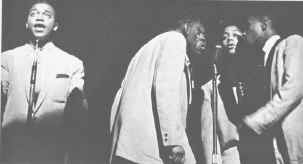
James Sheppard, Albert Crump,Bobby Tatum, Wally Rocker and Vernon Seaver
Lead singer James "Shep" Sheppard cowrote a series of velvety doo-wop ballads for The Heartbeats during the mid 50s; one entry, "A Thousand Miles Away," was a huge R&B seller in 1956. The Queens, NY, quintet began their string of street-corner classics with "Crazy for You" and "Darling How Long," culminating with "A Thousand Miles Away." The Heartbeats recorded for Hull, Rama, Roulette, Gee, and Guyden before packing it in. In 1961 the lead singer formed a new trio, Shep & The Limelites, and scored on the charts with a heartwarming sequel to his first hit, "Daddy's Home," for Hull. "Our Anniversary" also sold well for the trio the next year, but they broke up soon thereafter. Sheppard was found dead in his auto on the Long Island Expressway in 1970. ~ Bill Dahl, All-Music Guide
Long-lasting Los Angeles doo-wop aggregation with a very fluid personnel roster. Bobby Day was one of the group's founders in 1950, and they recorded prolifically for Hollywood, Specialty, Lucky, Swingtime, Money, and other firms before cutting their one major hit, the rocking ![]() "Buzz Buzz Buzz," in 1957 for Ebb Records. Earl Nelson, who was later half of Bob And Earl, sang lead on the tune, and some of their subsequent Ebb 45s were rocking novelties. Day went on to solo success with "Rockin' Robin," and the group managed one more chart item, "Gee," for Chess in 1961 with Donald Height as lead. ~ Bill Dahl, All-Music Guide
"Buzz Buzz Buzz," in 1957 for Ebb Records. Earl Nelson, who was later half of Bob And Earl, sang lead on the tune, and some of their subsequent Ebb 45s were rocking novelties. Day went on to solo success with "Rockin' Robin," and the group managed one more chart item, "Gee," for Chess in 1961 with Donald Height as lead. ~ Bill Dahl, All-Music Guide
The archetypal New York street-corner group, with soaring falsetto and stirring harmonies. With Adam Jackson And Lenny McKay sharing lead duties, The Jesters recorded several classics of the doo-wop genre for Winley in 1957 and 1958, including "So Strange" and "The Plea." Jackson recast the group in 1960 for their last Winley releases, including an accurate remake of The Diablos tune "The Wind." ~ Bill Dahl, All-Music Guide
The Jive Five

(top l-r) Norman Johnson, Richard Harris and Eugene Pitt
(bottom l-r) Billy Profit and Jerome Hanna
Best known for the number one R&B hit "My True Story," the Jive Five were one of the few vocal groups to survive the transistion from the '50s to the '60s. In the process, they helped move the music itself forward, providing a key link between doo wop and '60s soul.
Formed in Brooklyn, New York, the group originally consisted of Eugene Pitt (lead), Jerome Hanna (tenor), Richard Harris (tenor), Billy Prophet (baritone), and Norman Johnson (bass). The Jive Five's first hit, "My True Story," was their biggest, peaking at number one on the R&B charts and number three on pop charts in the summer of 1961. None of the band's subsequent singles -- including the minor R&B hit, 1962's "These Golden Rings" -- were as popular, but the group managed to keep performing and recording. Under the direction of Eugene Pitt and Norman Johnson, the Jive Five refashoined themselves as a soul band in 1964, forming a new lineup swith Casey Spencer (tenor), Webster Harris (tenor), and Beatrice Best (baritone). This new incarnation of the band signed to United Artists Records. The group only had one hit on UA, 1965's "I'm A Happy Man."
In 1966, the Jive Five left United Artists and signed with Musicor, where they had the 1968 R&B hit "Sugar (Don't Take Away My Candy)." They changed labels again in 1970, signing with Decca. That same year, they changed their name to the Jyve Fyve, in order to appear more contemporary. The Jyve Fyve had only one minor R&B hit, 1970's "I Want You To Be My Baby."
The group continued to perform and record for a variety of small labels during the '70s, but they never had another hit. Throughout the '70s and '80s, the only constant member was Eugene Pitt. In 1975, Pitt changed the name of the group to Ebony, Ivory, and the Jades, but this new incarnation failed to gain much attention. In 1982, Pitt changed the name of the group back to the Jive Five and the band recorded two albums for the indie label, Ambient Sound. For the rest of the '80s and the '90s, the Jive Five were regulars on the oldies circuit. ~ Stephen Thomas Erlewine, All-Music Guide
- Attachments:
Replies to This Discussion
-
You know these are my favorite type of groups.....SMILE
-
-
Mine too baby...mine too.
-
-
BIG SMILE...To a ERA that truly never left us....BIGGER SMILE
-
-
I forgot I did this!!! *hand over mouth* Thanks for placing a comment William!!! I need to put this over in the Doo Wop Group...plus add a track list. Did you hear "Angel" on the list? They are getting....down!!! #2 on there.
Regarding Eugene Pitt, I agree..and it's a miracle the groups back then did as well as they did with all that mob action going on behind the scenes... It was Wop'sploitation as in Doo...LOL -
-
Rap ... that's a genre I completely avoid, but I can believe it when you say they are exploited too.
When I read about the exploitation of the artists from the old dayz--I cringe. Did you see The Five Heartbeats? That famous scene..."now what are my hours??" "nine....gulp...to...moan...five" was said to have really happened to Jackie Wilson..please tell me Red Saunders wasn't Red...pleeeeeease!!! LOL
You might be interested in a blog I did entitled "Memory Lane"..I have a very young Jackie Wilson with a classic cut by him in there. -
-
Here's that blog I told you about: Memory Lane With Edie2k2
You are gonna flip listening to the 17yr old Jackie Wilson... -
© 2025 Created by Edie Antoinette.
Powered by
![]()
